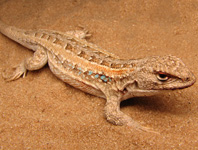Abstract
The Eumicrotremus asperrimus species complex includes three nominal species from the eastern North Pacific and Bering Sea: Eumicrotremus gyrinops (Garman 1892); Eumicrotremus muticus (Gilbert 1896); and Eumicrotremus phrynoides Gilbert & Burke 1912. These species have been distinguished from each other primarily on the basis of the strength and coverage of bony tubercles on the head and body. However, several recent genetic studies have cast doubt on the utility of bony tubercles for diagnosing species-level differences among cyclopterids, and a recent genetic study of the E. asperrimus species complex indicated that population structure is not correlated with tubercle development. Here we present additional evidence from the mitochondrial COI gene indicating that there is little genetic structure within a sample of specimens from the eastern North Pacific and Bering Sea with a wide range of tubercle development. We also examine several lines of morphological evidence, including meristic and morphometric data and osteology, and conclude that the three nominal species described from the eastern North Pacific represent a single polymorphic species. We present a redescription of Eumicrotremus gyrinops (Garman), the oldest of the three nominal species, recognizing the other two nominal species of the Eumicrotremus asperrimus species complex described from the eastern North Pacific as junior synonyms. Individuals of this highly polymorphic species may be covered in large bony tubercles, or sparsely covered in small tubercles, or may have no evidence of tubercles at all. There is clear evidence of sexual dimorphism, as males tend to have fewer and smaller tubercles than females, and all large specimens (> 58 mm SL) are females. Both males and smaller females may lack any evidence of tubercles.
References
Arita, G.S. (1969) Sexual dimorphism in the cyclopterid fish Eumicrotremus orbis. Journal of the Fisheries Research Board of Canada, 26, 3262–3265.
https://doi.org/10.1139/f69-312Byrkjedal, I., Rees, D.J. & Willassen, E. (2007) Lumping lumpsuckers: molecular and morphological insights into the taxonomic status of Eumicrotremus spinosus (Fabricius, 1776) and Eumicrotremus eggvinii Koefoed, 1956 (Teleostei: Cyclopteridae). Journal of Fish Biology, 71 (Supplement A), 111–131.
https://doi.org/10.1111/j.1095-8649.2007.01550.xGarman, S. (1892) The Discoboli: Cyclopteridae, Liparopsidae, and Liparididae. Memoirs of the Museum of Comparative Zoology, 14 (2), 1–96.
Gilbert, C.H. (1896) The ichthyological collections of the steamer Albatross during the years 1890 and 1891. U. S. Commission of Fish and Fisheries, Report of the Commissioner, 19, 393–476.
Gilbert, C.H. & Burke, C.V. (1912) Fishes from Bering Sea and Kamchatka. Bulletin of the Bureau of Fisheries, 30, 31–96.
Goloboff, P.A., Farris, J.S. & Nixon, K.C. (2003) TNT: Tree Analysis Using New Technology. Program and documentation available from the authors. Available from: http://www.lillo.org.ar/phylogeny/tnt/ (accessed 23 May 2017)
Goloboff, P.A., Farris, J.S. & Nixon, K.C. (2008) TNT, a free program for phylogenetic analysis. Cladistics, 24, 774–786.
https://doi.org/10.1111/j.1096-0031.2008.00217.xHatano, M., Abe, T., Wada, T. & Munehara, H. (2015) Ontogenetic metamorphosis and extreme sexual dimorphism in lumpsuckers: Eumicrotremus asperrimus, Cyclopteropsis bergi, and Cyclopteropsis lindbergi, may be synonymous. Journal of Fish Biology, 86, 1121–1128.
https://doi.org/10.1111/jfb.12627Huelsenbeck, J.P. & Ronquist, F. (2001) MRBAYES: Bayesian inference of phylogenetic trees. Bioinformatics, 17, 754–755.
https://doi.org/10.1093/bioinformatics/17.8.754Kai, Y., Stevenson, D.E., Ueda, Y., Hamatsu, T. & Nakabo, T. (2015) Molecular insights into geographic and morphological variation within the Eumicrotremus asperrimus species complex (Cottoidei: Cyclopteridae). Ichthyological Research, 62, 396–408.
https://doi.org/10.1007/s10228-014-0453-4Lindberg, G.U. & Legeza, M.I. (1955) Review of the genera and species of the subfamily Cyclopterinae (Pisces). Trudy Zoologicheskogo Instituta Akademii Nauk SSSR, 18, 389–458. [in Russian. English translation by Israel Program for Scientific Translations, 1964]
Mecklenburg, C.W. & Anderson, M.E. (2015) Reassessment of multiple species of Gymnelus (Teleostei: Zoarcidae) in Pacific Arctic and boreal regions. Zootaxa, 3948 (2), 263–278.
https://doi.org/10.11646/zootaxa.3948.2.7Mecklenburg, C.W., Mecklenburg, T.A. & Thorsteinson, L.K. (2002) Fishes of Alaska. American Fisheries Society, Bethesda, Maryland, xxxvii + 1037 pp.
Mecklenburg, C.W. & Sheiko, B.A. (2003) Family Cyclopteridae Bonaparte 1831—lumpsuckers. California Academy of Sciences Annotated Checklist of Fishes, No. 6, 1–17.
Mecklenburg, C.W. & Steinke, D. (2015) Ichthyofaunal baselines in the Pacific Arctic region and RUSALCA study area. Oceanography, 28, 158–189.
https://doi.org/10.5670/oceanog.2015.64Oku, K., Imamura, H. & Yabe, M. (2017) Phylogenetic relationships and a new classification of the family Cyclopteridae (Perciformes: Cottoidei). Zootaxa, 4221, 1–59.
Popov, A.M. (1930) A short review of the fishes of the family Cyclopteridae. Annals and Magazine of Natural History, 6, 69–76.
https://doi.org/10.1080/00222933008673190Potthoff, T. (1984) Clearing and staining techniques. In: Moser, H.G., Richards, W.J., Cohen, D.M., Fahay, M.P., Kendall, A.W. Jr. & Richardson, S.L. (Eds.), Ontogeny and Systematics of Fishes. Special Publication Number 1. American Society of Ichthyologists and Herpetologists, Lawrence, Kansas, pp. 35-–37.
Ronquist, F. & Huelsenbeck, J.P. (2003) MrBayes 3: Bayesian phylogenetic inference under mixed models. Bioinformatics, 19, 1572–1574.
https://doi.org/10.1093/bioinformatics/btg180Sabaj Pérez, M.H. (Ed.) (2016) Standard symbolic codes for institutional resource collections in herpetology and ichthyology: an Online Reference. Version 6.5 (16 August 2016). American Society of Ichthyologists and Herpetologists, Washington, D.C. Available from: http://www.asih.org (accessed 1 December 2016)
Soldatov, V.K. & Lindberg, G.U. (1930) A review of the fishes of the seas of the Far East. Izvestia Tikhookeanskogo Nauchno-Issledovatelskogo Instituta Rybnogo Khozyaystva y Okeanografii, 5, 1–576.
Steinke, D., Zemlak, T.S. & Hebert, P.D.N. (2009) Barcoding Nemo: DNA-based identifications for the ornamental fish trade. PLoS ONE, 4, e6300.
https://doi.org/10.1371/journal.pone.0006300Tamura, K., Stecher, G., Peterson, D., Filipski, A. & Kumar, S. (2013) MEGA6: Molecular Evolutionary Genetics Analysis Version 6.0. Molecular Biology and Evolution, 30, 2725–2729.
https://doi.org/10.1093/molbev/mst197Ueno, T. (1970) Cyclopteridae (Pisces). Fauna Japonica. Academic Press of Japan, Tokyo, 233 pp.
Voskoboinikova, O.S. & Chernova, N.V. (2016) Revalidation of the Eggvin lumpsucker Eumicrotremus eggvinii (Cyclopteridae) and its new finding near Franz Josef Land (Barents Sea). Journal of Ichthyology, 56, 31‒36.
https://doi.org/10.1134/S0032945216010161

